- Excellent engine & dual clutch
- Engaging handling
- Well-presented interior
- Firm ride won't suit everyone
- Tyres overwhelmed by grunt
- Misses out on hardcore options
It’s a turbulent time for Renault in Australia. Just last week the French brand’s local arm revealed the fifth-generation Clio, its best-selling car in Europe, won’t be making it across the pond and the slow-selling Kadjar will be axed in favour of the Korean-sourced Arkana – a coupe SUV that will sit between the all-new Captur and facelifted Koleos. At least hot hatch enthusiasts can rejoice, as Renault Australia has committed to keeping the Renault Sport Megane – including the 2020 Renault Megane RS300 Trophy – as its sole non-SUV, non-LCV offering. They’d be silly not to, considering Australia is third-largest market for Renault’s go-fast division in the world – only behind France and the UK.
There’s a lot of pressure mounting on the RS300 Trophy’s shapely shoulders then, as it serves as Renault’s flagship model. Gone is the three-door coupe-esque body, replaced with a traditional five-door hatchback. While some of the visual drama of the three door is gone, the new Megane still stands out as a striking offering in what is a crowded market. The front and rear fenders are wider than the normal Megane, and there’s the Formula One-style blade in the front intake flanked by chequered flag foglights. How quintessentially Renault Sport. At the rear you’re greeted by those elongated rear DRLs that almost meet in the middle of the hatch and a large, centrally mounted exhaust that is neatly integrated into the rear diffuser.
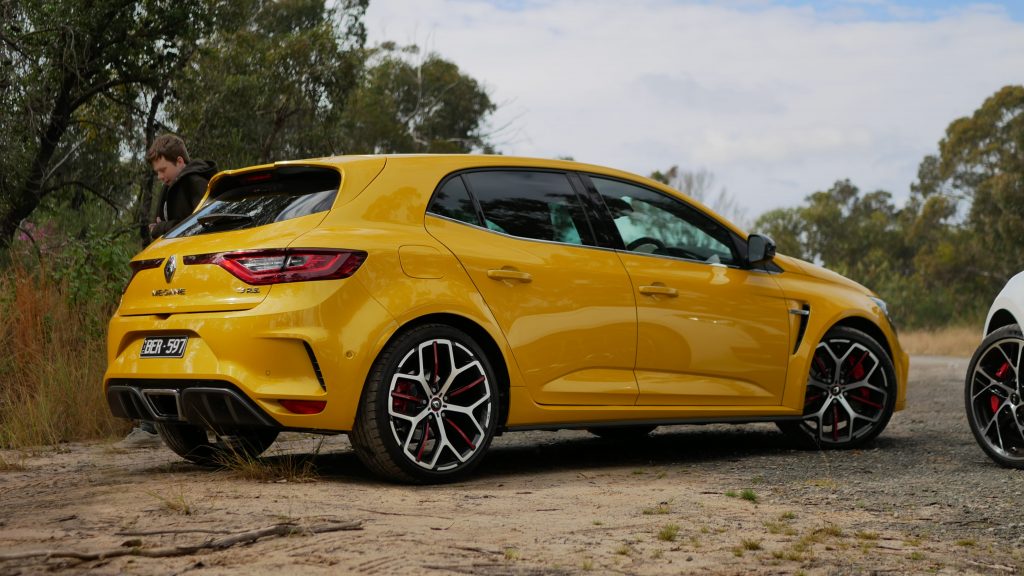
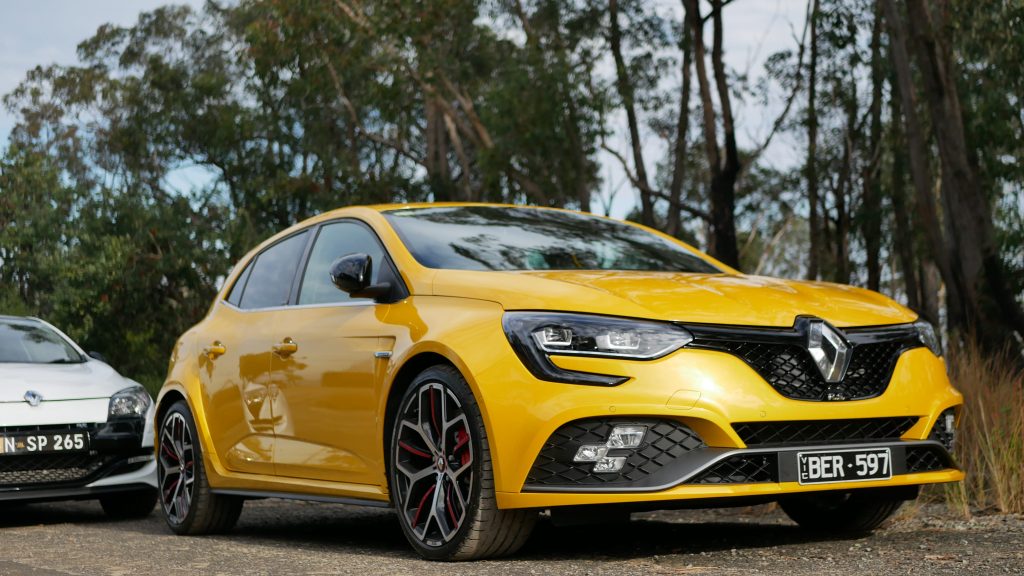
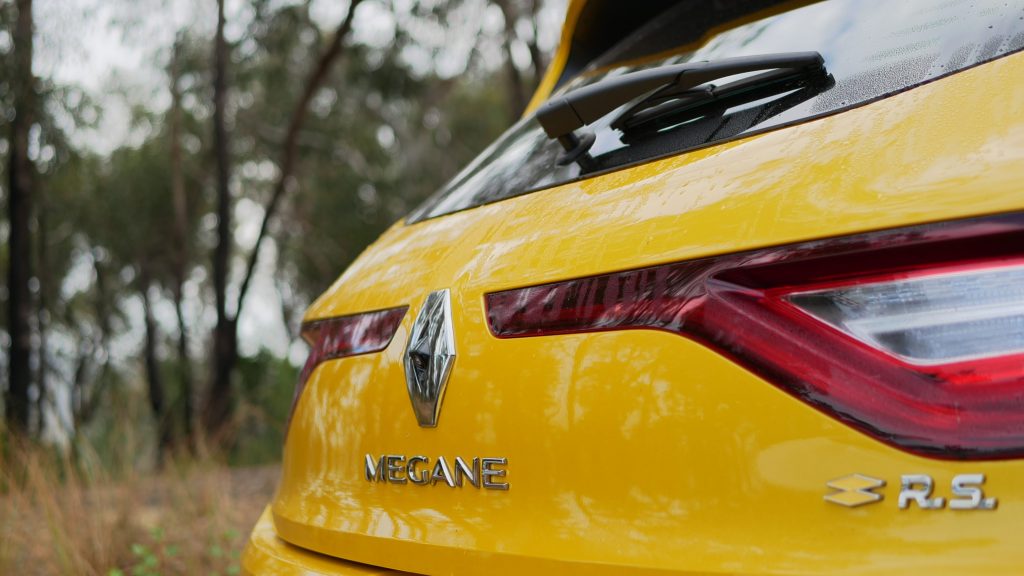
Price & Specs: 8.5/10
Now that the Megane range has been rationalised to just three Renault Sport variants (we won’t include the Trophy R as they’re all accounted for). The range kicks off with the RS280 Sport EDC (Renault speak for dual-clutch transmission) at $51,990 plus on roads. Next up is the RS280 Cup EDC from $52,490. We’re testing the flagship of the range – the 2020 Renault Megane RS300 Trophy.
The manual starts at $53,490 plus on roads and the dual-clutch adds another $3,000 on top of that. While Renault Sport models have traditionally been a manual-only proposition, the most recent RS Clio ditched the third pedal altogether as Renault Sport decided to chase 0-100 times and volume over what many argue is a purer driving experience. Luckily for us, the latest Megane gives you the option of choosing how you likes to shift your gears.
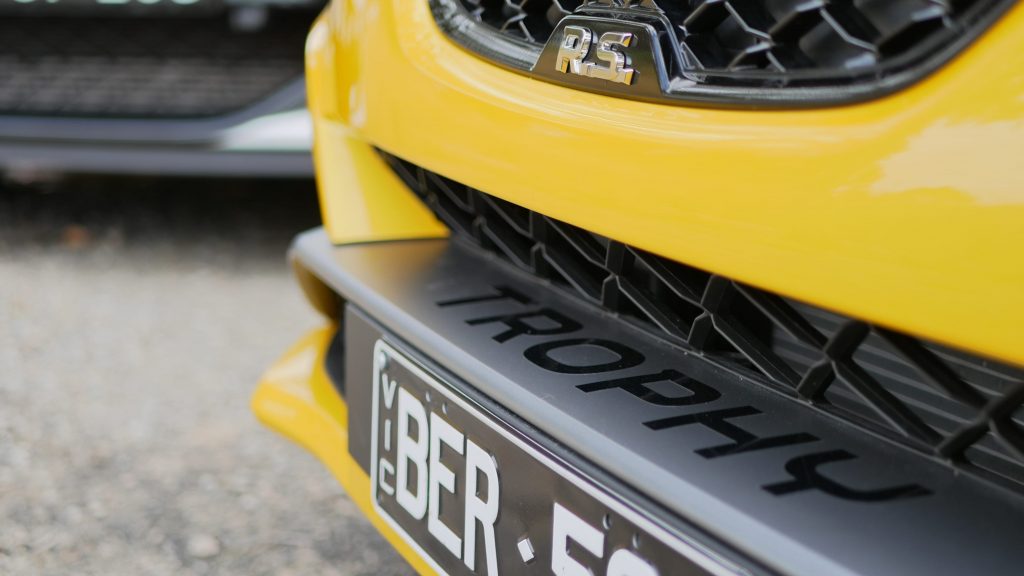
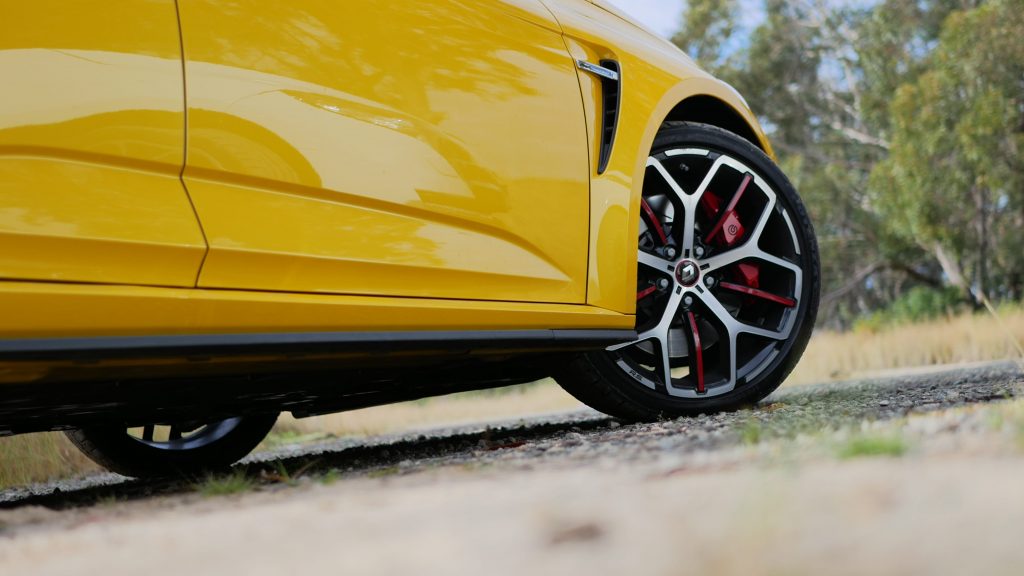
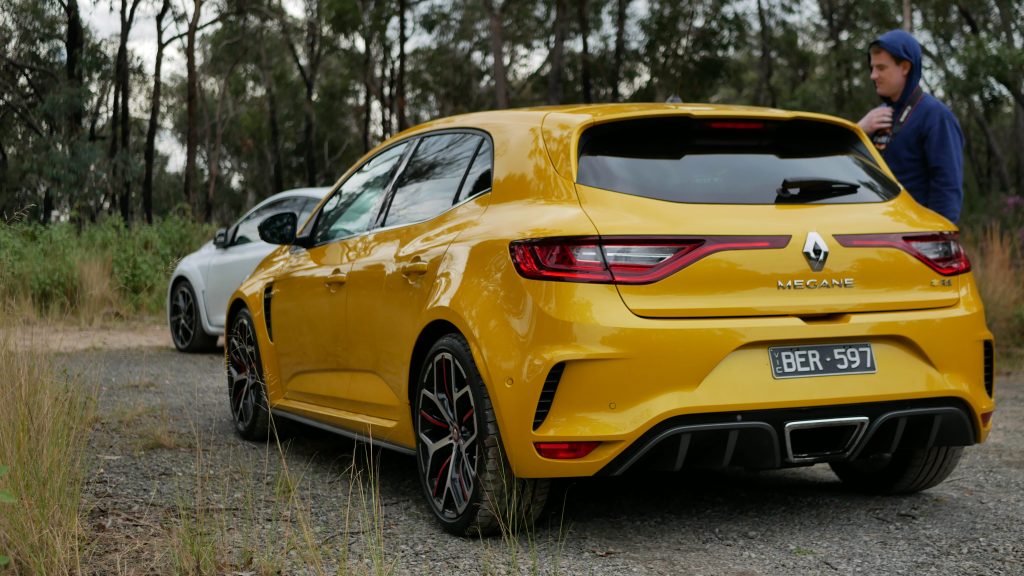
The Trophy does little to differentiate itself from the Megane RS280, with only the silver, black and red 19” alloys and the ‘Trophy’ emblem in the front diffuser letting you know this is the RS280’s beefier brother. Other than that, it builds on the standard RS Megane, meaning it gets automatic LED headlights with ‘RS Vision’ multi-functional front lights, LED front and rear daytime running lights, 360º parking sensors with automatic parking assistance, 19” tri-tone alloy wheels, tyre-pressure monitoring, Renault Sport bucket seats wrapped in Alcantara, aluminium column-mounted paddle shifters, proximity keycard with push button start, automatic folding mirrors, interior ambient lighting, dual-zone climate control, 8.7-inch infotainment touchscreen with Apple CarPlay and Android Auto, a nine-speaker Bose sound system with subwoofer, and a 7-inch digital driver’s display. On the safety front, the Megane range gets autonomous emergency braking with adaptive cruise control and distance warning, blind spot monitoring and lane departure warning. The only options available are metallic paint – $800 for black or silver, $1,000 for the hero ‘Tonic Orange’ or ‘Liquid Yellow’ – and a $2,000 panoramic sunroof.


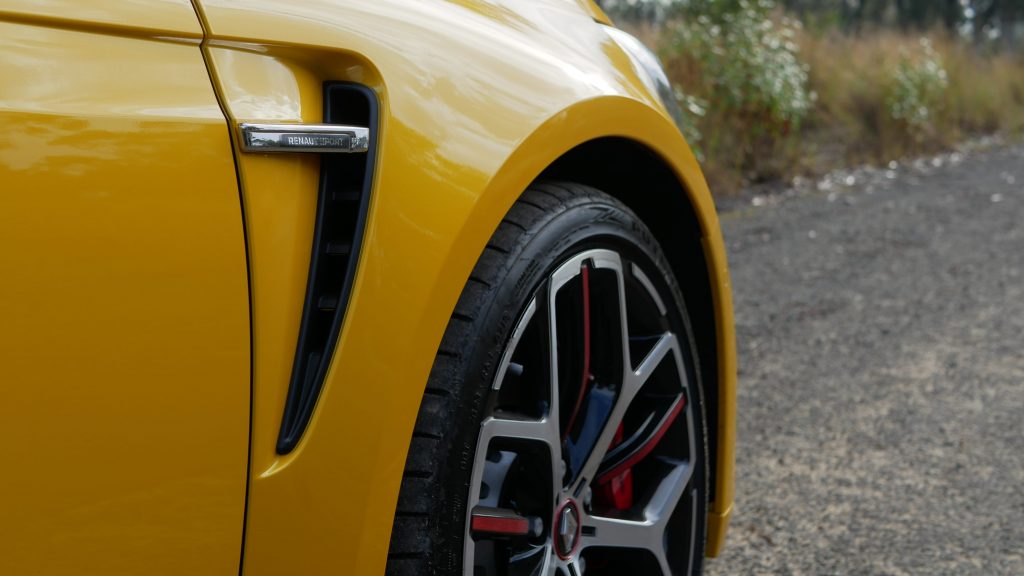
Curiously, European Trophy’s can be optioned with Recaro seats and lightweight alloy wheels fitted with stickier Bridgestone Potenza S007 tyres. This would help shave 2kg of unsprung weight per corner but remains missing from the Australian spec sheet.
Performance & Economy: 9/10
The RS300 uses the same 1.8-litre turbocharged four-cylinder engine as the RS280 but it’s been massaged for extra poke. There’s a new turbo, that spools quicker thanks to ceramic ball bearings, which bumps it up from 205kW/380Nm to 221kW/420Nm (the manual produces 400Nm). There’s also a new active valve exhaust and a lightweight lithium-ion battery. This all helps the Trophy launch from 0-100 in 5.7 seconds, matching the Honda Civic Type R.
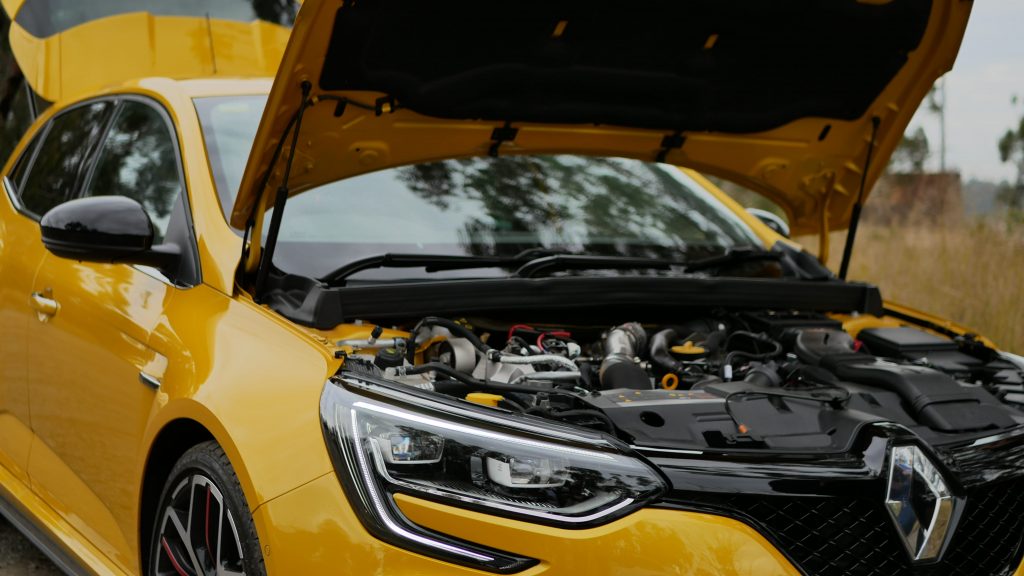
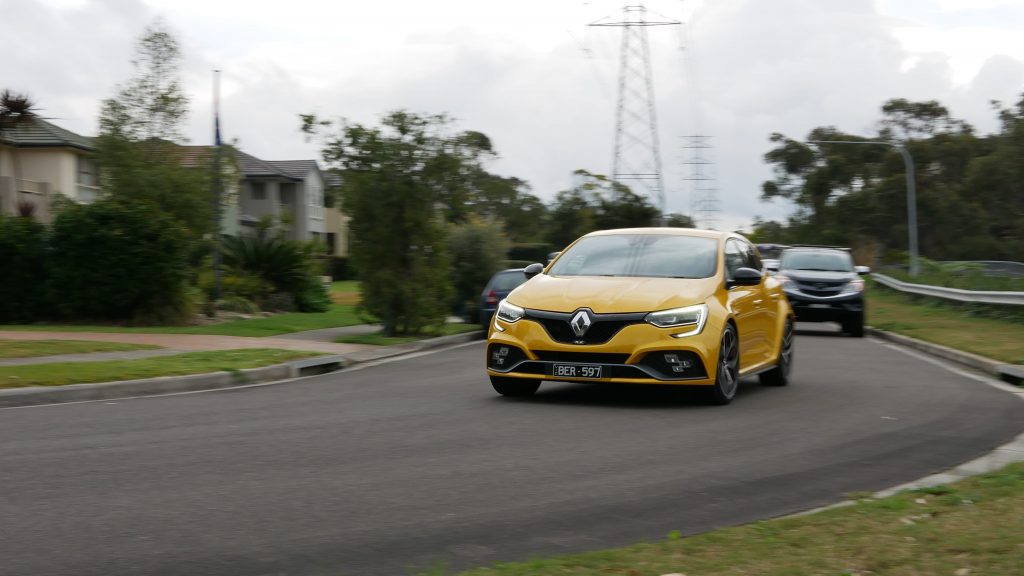
On a cold start you’re greeted with a deep growl from the exhaust before the engine gets up to temperature. That’s when it surprises you with its oddly civilised and almost hushed engine note when just pottering around in neutral mode. Swapping into sport or race mode opens up that bi-modal exhaust, which really starts encouraging you to push it harder (just make sure to turn off that artificial engine noise coming through the sound system). Every tap of the throttle and every downshift is greeted with a series of pops and crackles that are utterly addictive. The power delivery is instant thanks to the new turbo, which goes a long way to eliminating lag. The torque feels endless, helping the climb through the gears rapidly once it finally manages to scrabble for grip and put the power down.
The dual-clutch transition is a great example of the type of gearbox, with very little in the way of low-speed hesitation. If you leave it in auto it’s intuitive enough to respond to your driving such – dropping down gears when braking hard or holding a gear as you power through a corner. If you take matters into your own hand and flick it into manual mode, the gear changes are rifle-bolt fast and the tactility of the aluminium column-mounted paddles are almost as satisfying as slick-shifting manual. Multi downshift, which jumps to the lowest possible ratio at the current speed when you hold down the left paddle, is also a nice touch.
“…the gear changes are rifle-bolt fast and the tactility of the aluminium column-mounted paddles are almost as satisfying as slick-shifting manual.”
The launch control is dead easy to use, too. Simply pull back both paddles together while in sport or race mode, mash both peddles down and wait for the three green lights in the driver’s display to light up before releasing the brake pedal.
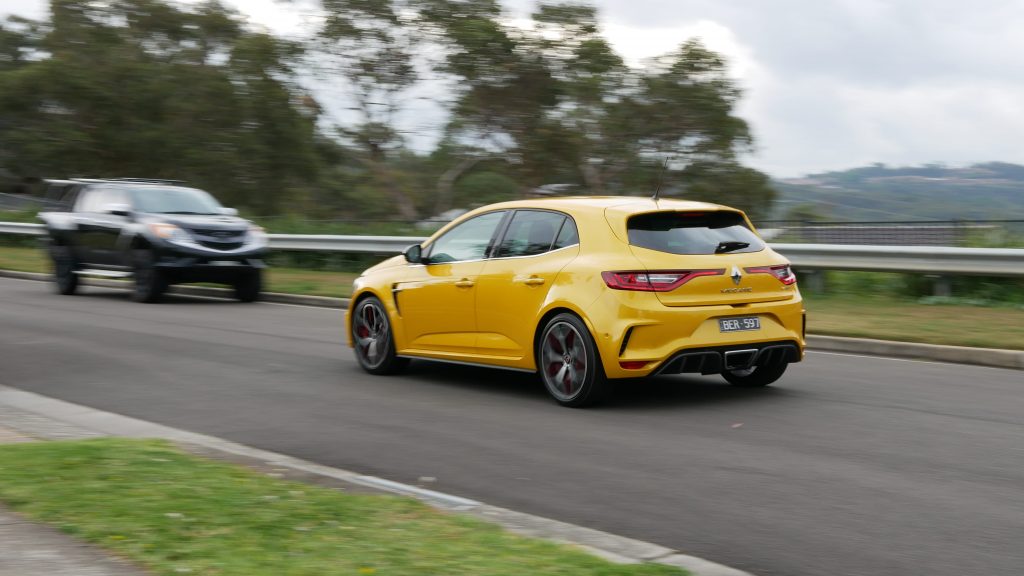
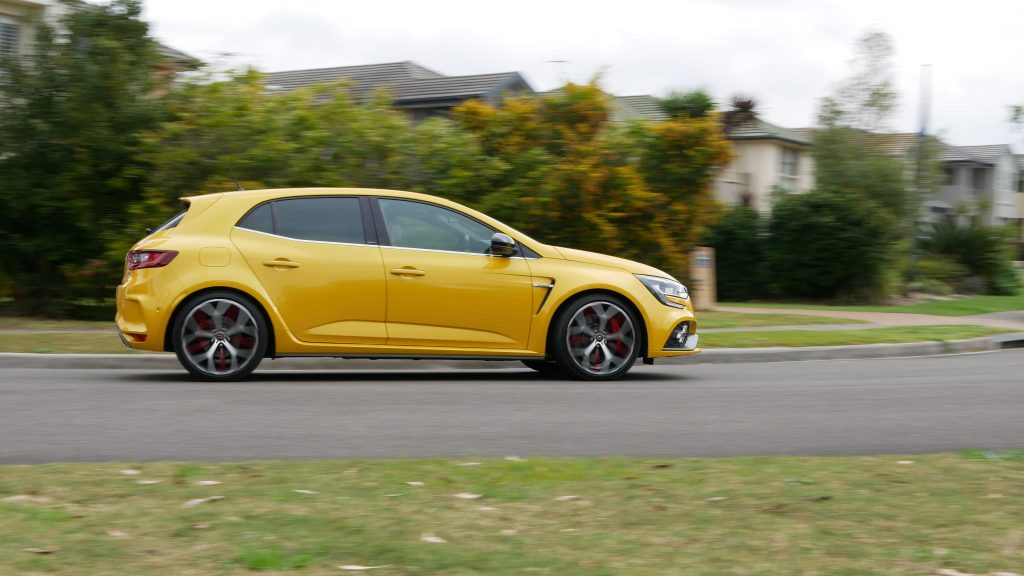
If you’re going to drive this car the way it’s intended to be driven you’ll be hard pressed to match the claimed consumption figure of 8.0L/100km. We spent most of our time in sport mode, which disables stop start, and driving with vigour which lead two a less-than-favourable average consumption of 11.5L/100km. We have no doubt that the Trophy is capable of lower figures than that, but if you’re driving a hot hatch for good economy you’re missing the point. The 2020 Renault Megane Trophy also requires premium fuel, but that’s par for the course with most hot hatches.
Ride & Handling: 9.5/10
The 2020 Renault Megane Trophy comes standard with the Cup chassis, which includes a limited-slip differential, lightweight bi-material Brembo brakes and hydraulic bump stops. Sticking with a more basic torsion beam at the rear, the Megane gets tried-and-tested passive dampers rather than the adaptive setups so many rivals are switching to.
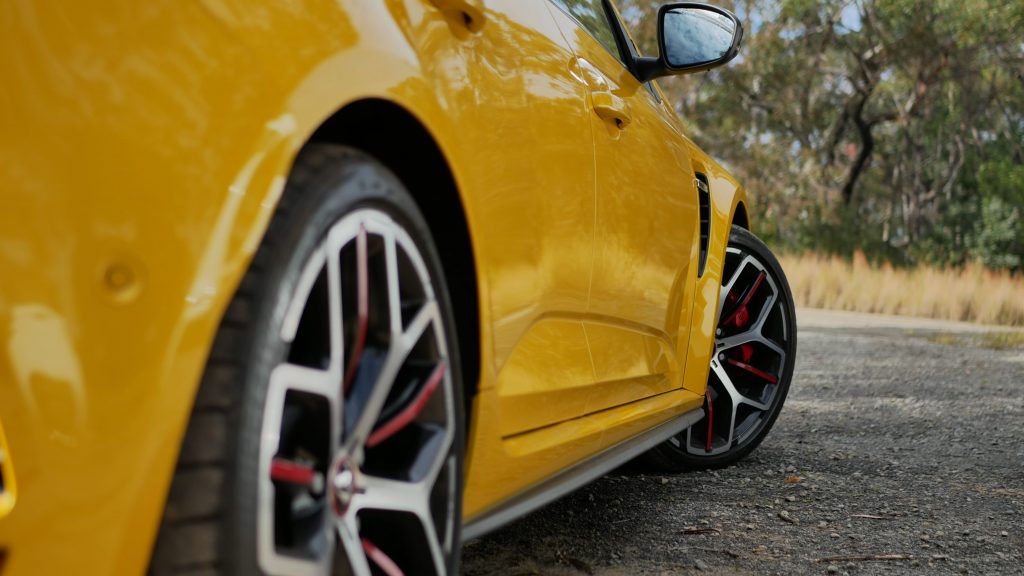
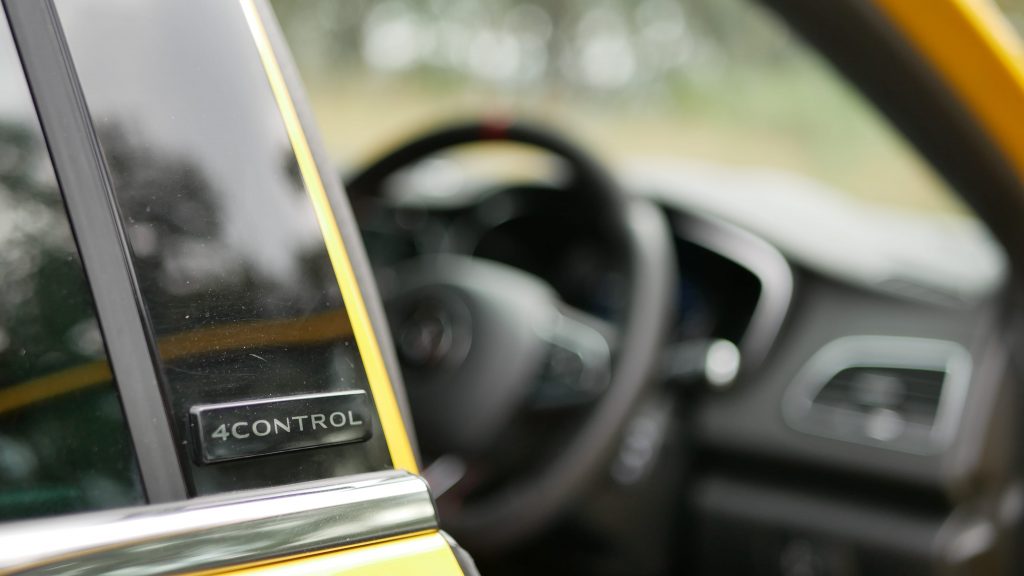
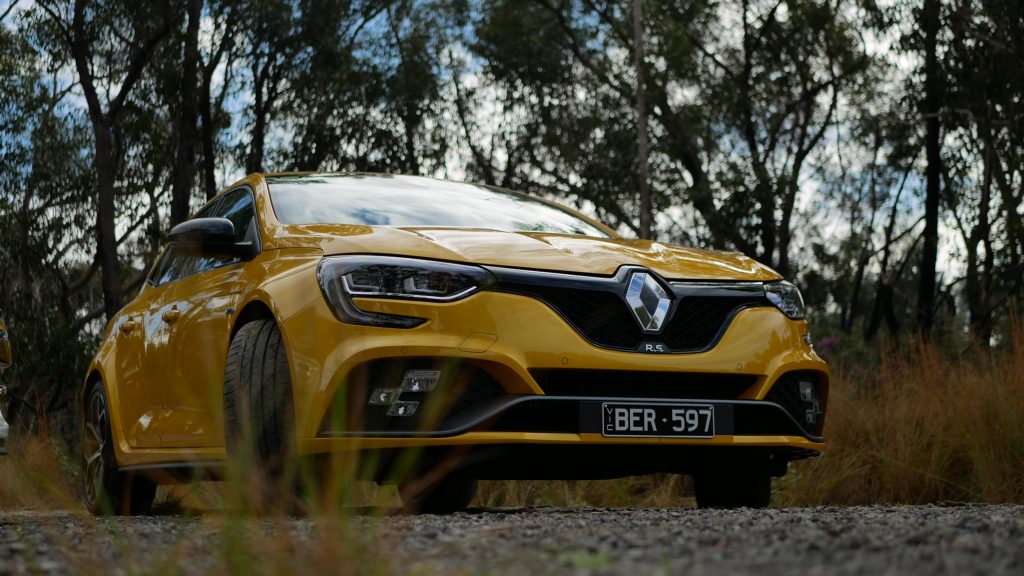
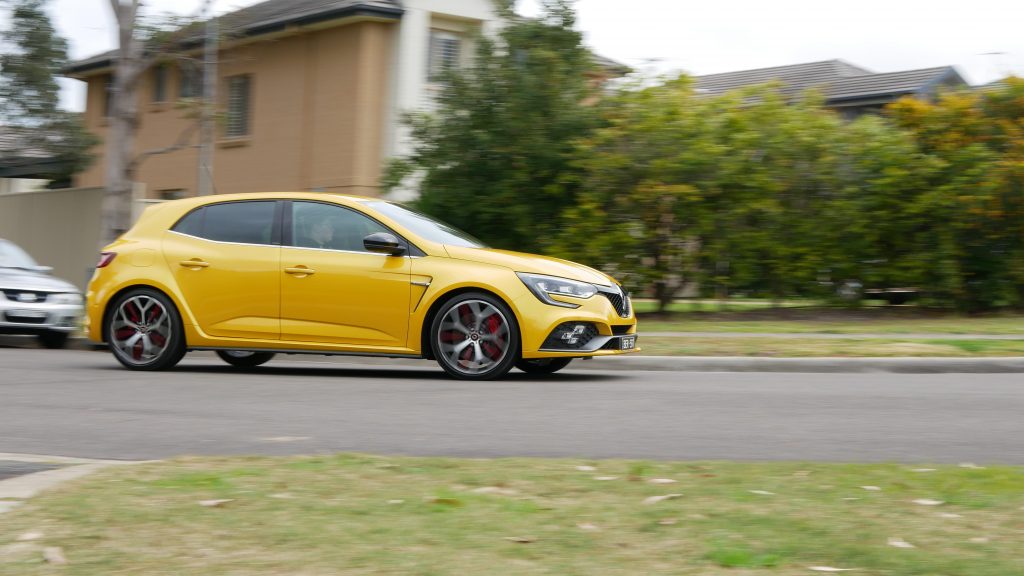
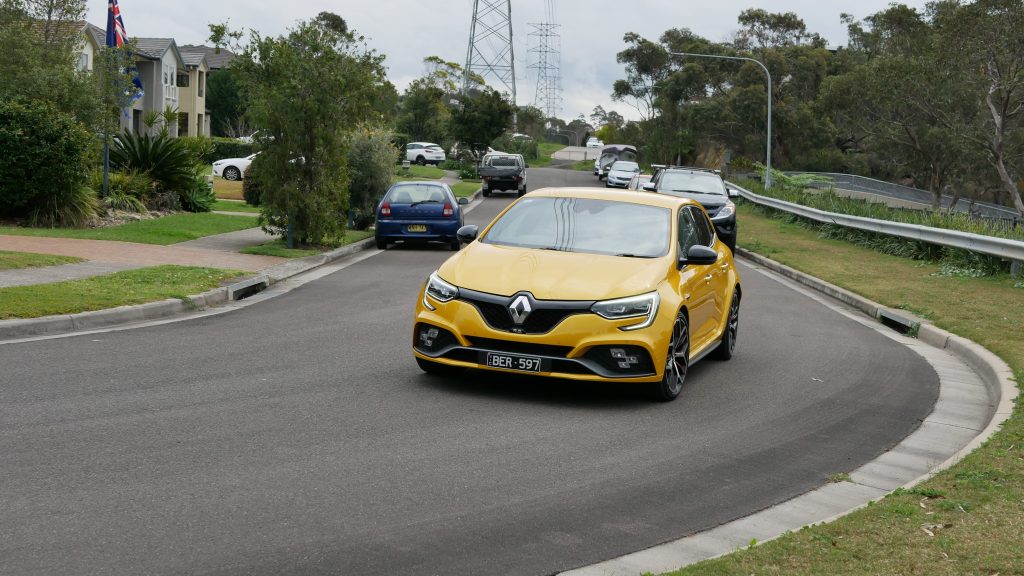
The controversial four-wheel steering system is also carried over from the RS280. It’s by no means a bad system and it brings with it some serious advantages, such as incredible agility at speed and a reduced turning circle, but it doesn’t feel as natural as Renault Sports of past and takes some acclimatisation. The steering feels hyperactive at first – requiring you to reduce your lock as the car turns harder than you initially anticipated. It takes a bit of time to learn and adapt to, but once you do it makes the 1,452kg hatch feel like it’s 200kg lighter.
As you gain confidence and learn how the car moves, you can really start to exploit the chassis. The stiffer springs and dampers mean that it stays flat as you push it through corners. You get the sensation that the car almost pivots underneath you as the four-wheel steering turns the rear wheels in the opposite direction to the front wheels, at up to 80km/h in sport mode. There is virtually no understeer when pushing hard through corners. You simply put your foot down, let the LSD dig in and pull you out. It’ll even surprise you as the rear end gets playful as you lift off the throttle or under hard braking.
“You get the sensation that the car almost pivots underneath you as the four-wheel steering turns the rear wheels in the opposite direction to the front wheels…”
The bi-material Brembo brakes do a phenomenal job of wiping speed off while maintaining pedal feel in spirited backroad driving. The only real chink in the armour are the 245/35R19 Bridgestone Potenza S001s, which break traction in first and second at the flex of your ankle. The overseas-only lightweight alloys with Potenza S007s are suddenly looking like a bit of an oversight. As is the lack of offering Recaro seats locally.
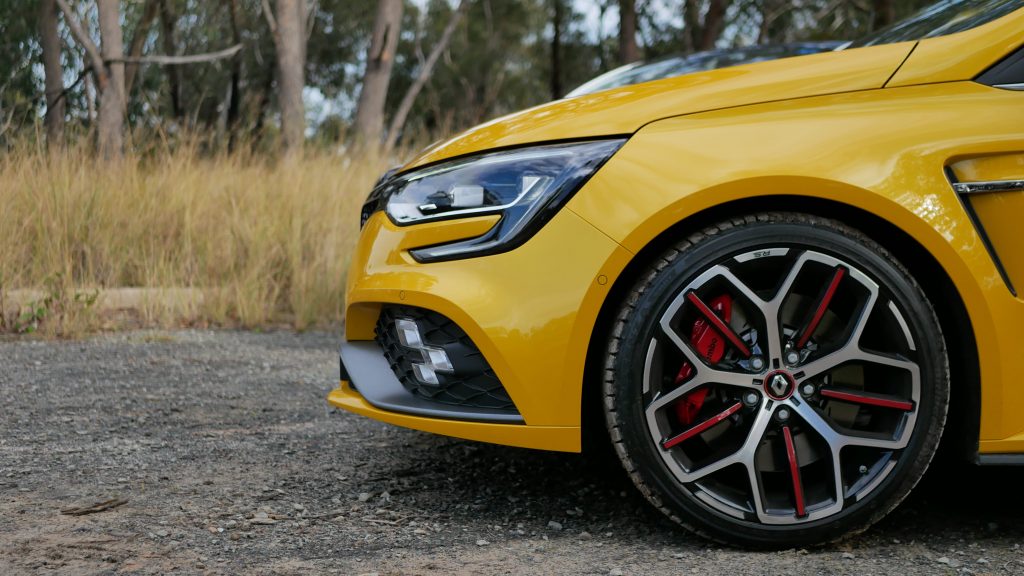
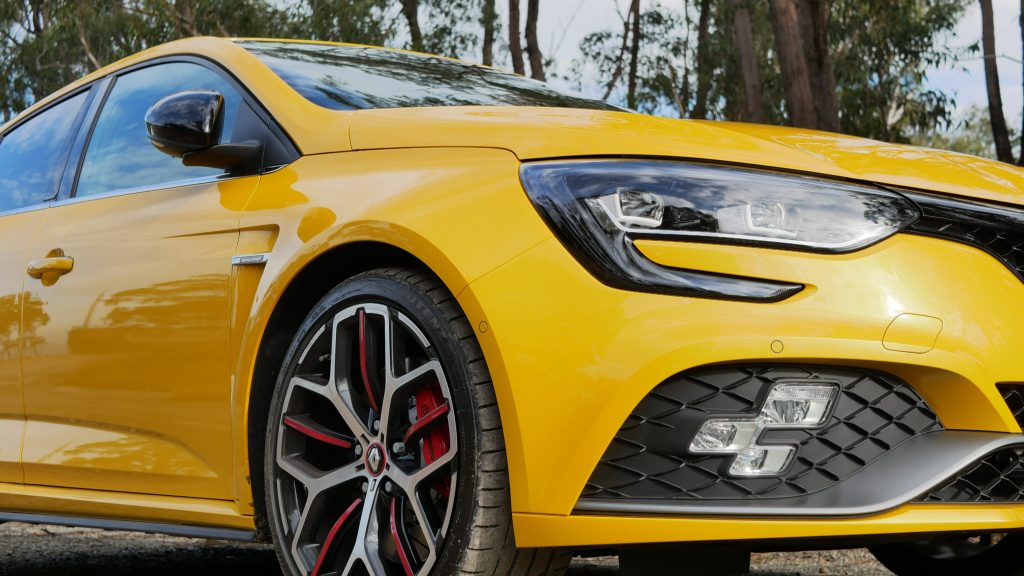
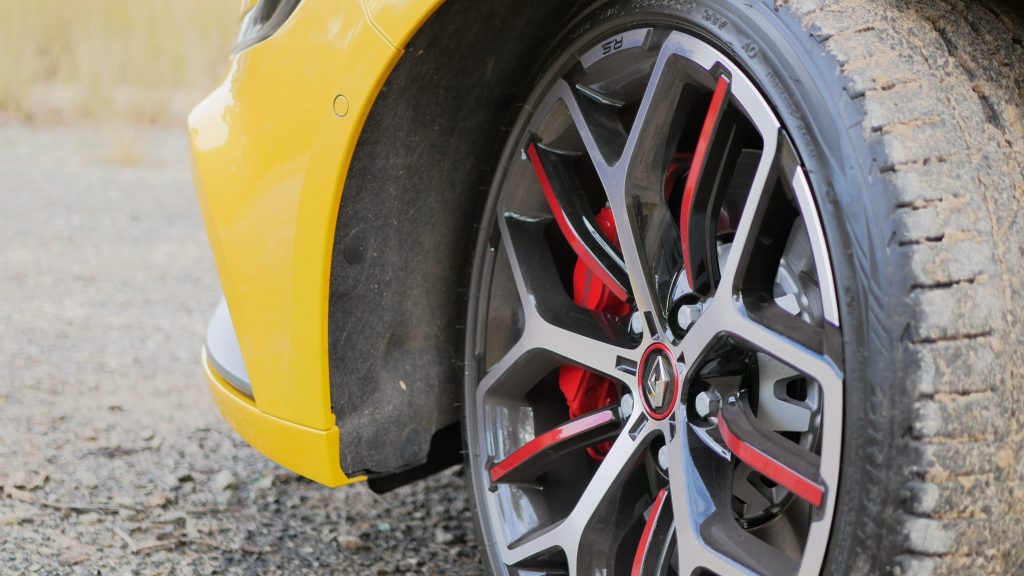

In daily use the suspension is very firm without being unbearably so. It fidgets at lower speeds but it settles noticeably as you pick up the pace, and the hydraulic bumps stops do a great job at ironing out bigger hits. Still, a Volkswagen Golf R or Honda Civic Type R feel genuinely cosseting in comfort mode by comparison.
Interior & Practicality: 9/10
The 2020 Renault Megane Trophy’s interior is a nice place to spend time. Walk up to the car and you’re greeted with LED lights and mirrors folding out thanks to the proximity key. Open the door and lower yourself into the Renault Sport bucket seats, which are the same as those from the standard RS280, and you’ll find they offer an excellent blend of comfort and support for daily use. Hardcore driver’s will no doubt miss the option of Recaros that are available overseas. At least the RS buckets looks suitably sporty with red stitching, are positioned low in the cabin and the charcoal Alcantara keeps those with a smaller frame from sliding around.
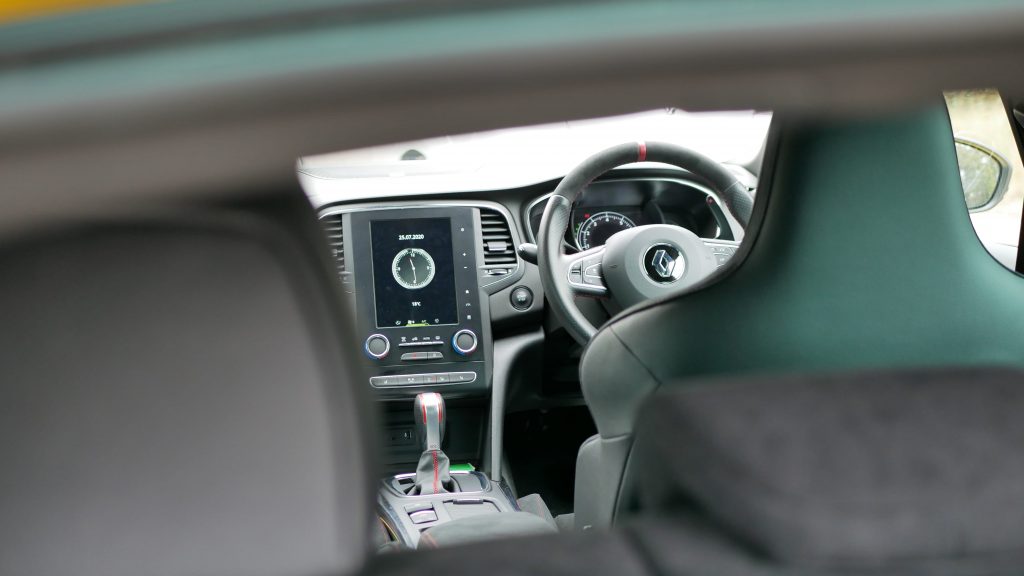
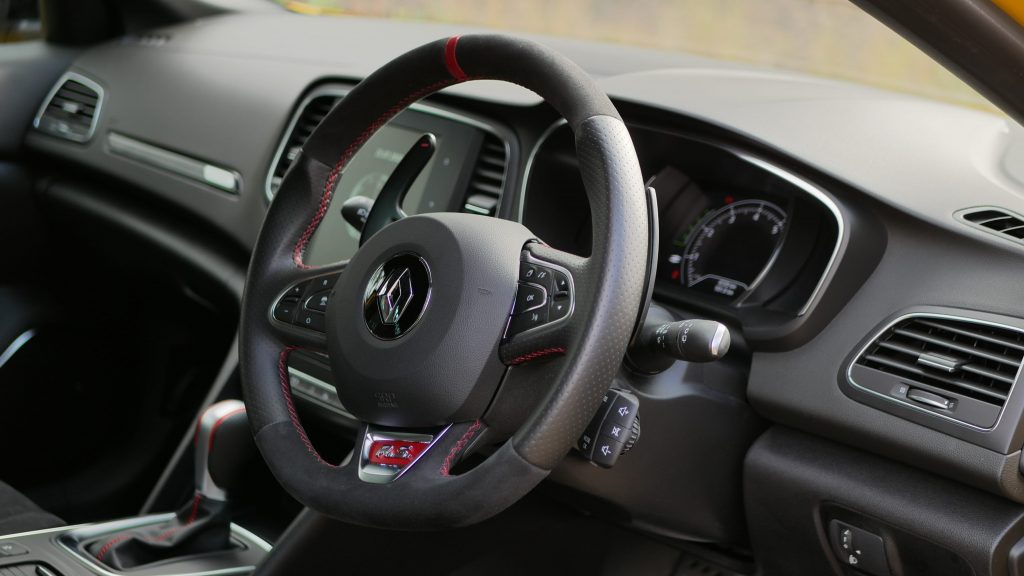
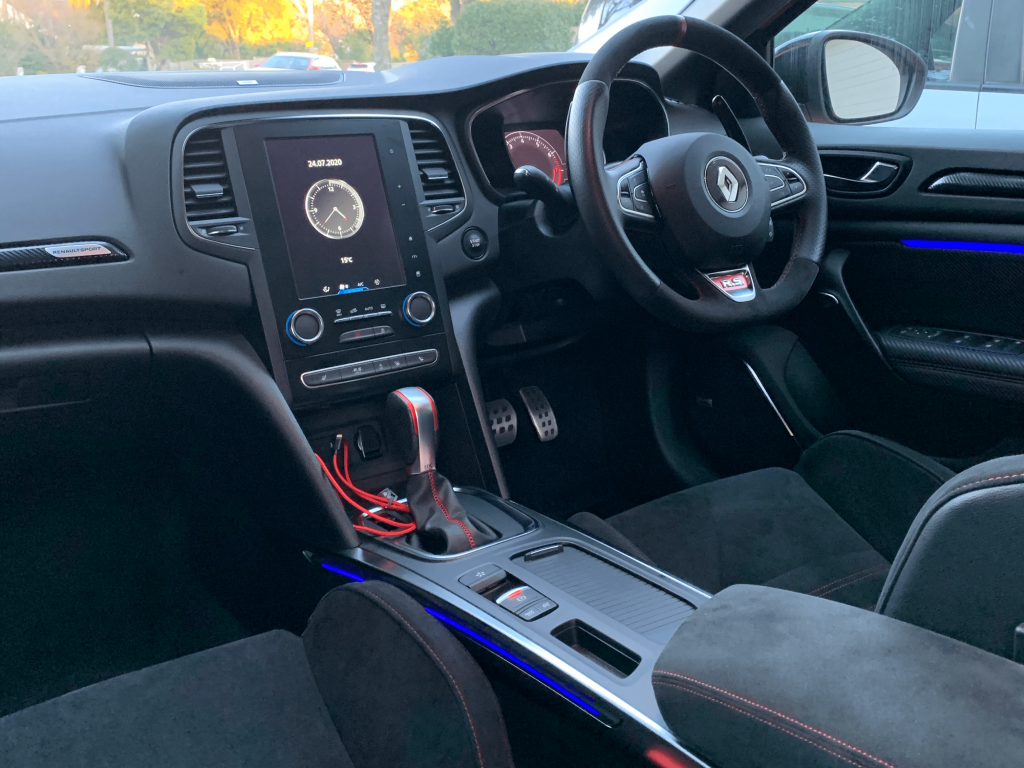
The rest of the interior is of a good quality, with soft touch plastics where you expect them to be for the class, and it all feels well screwed together. The doors even close with a Golf-like thud, which you could never have said about an older Megane. The atmosphere is dark but is lifted by neatly integrated ambient lighting, splashes of carbon trim, satin chrome highlights and two screens in front of the driver.
“The doors even close with a Golf-like thud, which you could never have said about an older Megane.”
The first is a clear 7-inch TFT display that sits in front of the driver instead of conventional dials. It’s not as comprehensive as what you get in some of its German rivals, but it’s bright, clear and highly configurable to change with the various drive modes. There’s even a racy Formula One-style rev counter. It also shows clever details for the driver’s aids, such as using the radar to calculate in seconds how closely you’re following the car in front. Said driver’s aids are also very well calibrated – the radar cruise doesn’t lurch or brake unnecessarily and the AEB doesn’t panic over false alarms.
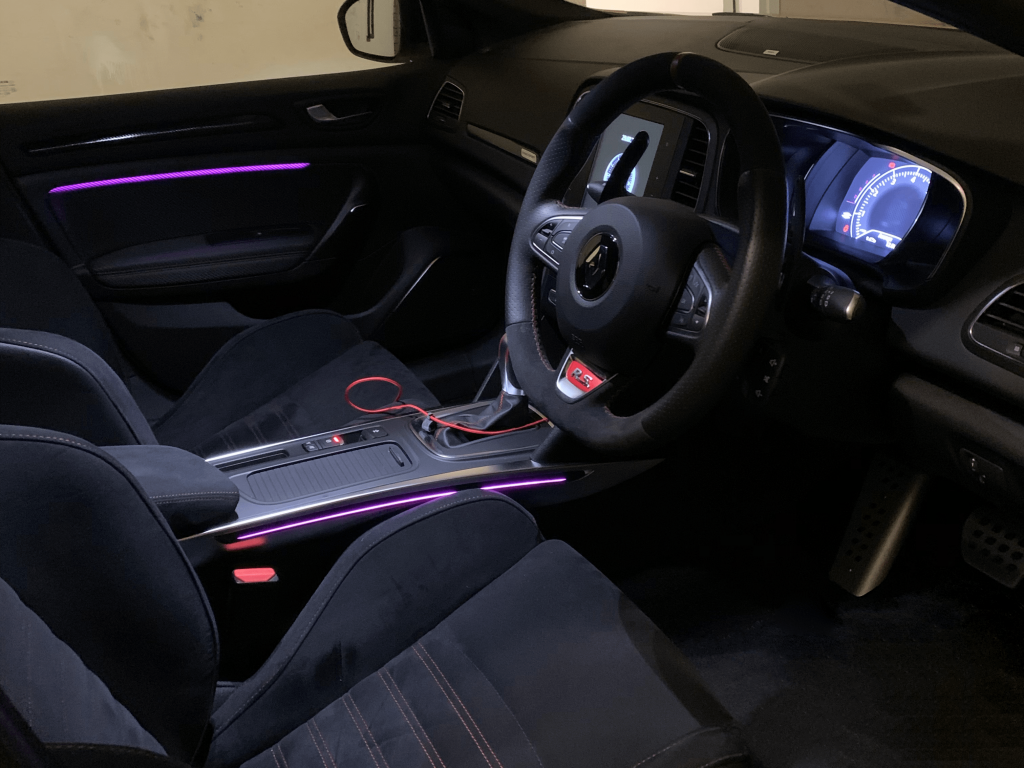
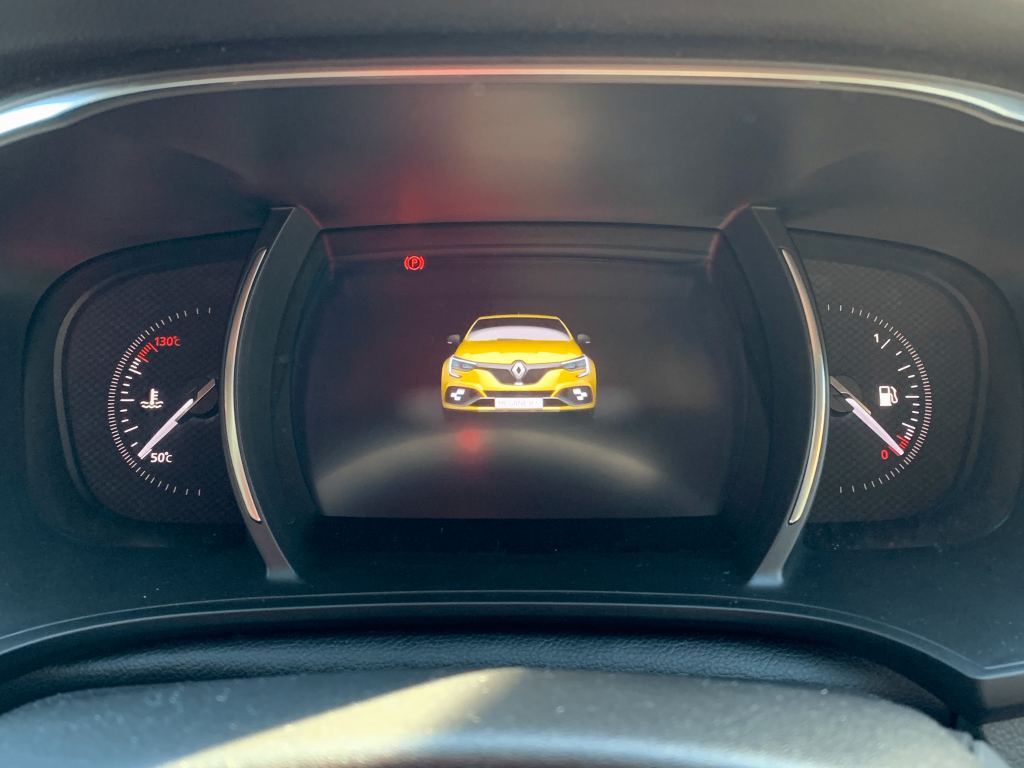
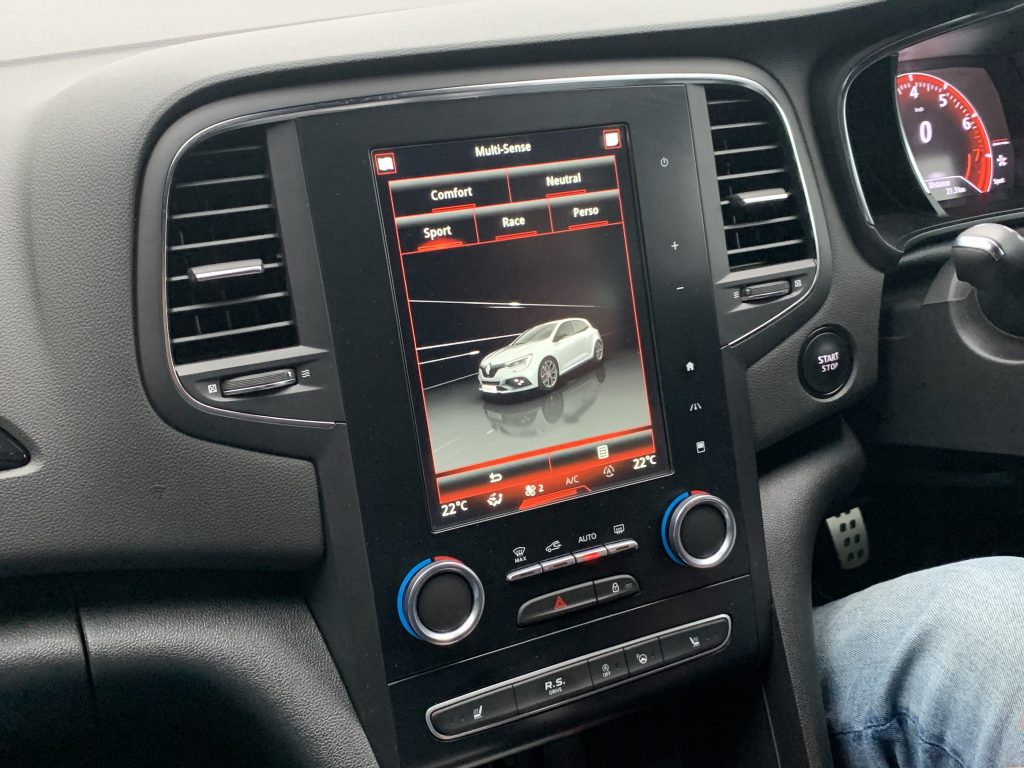
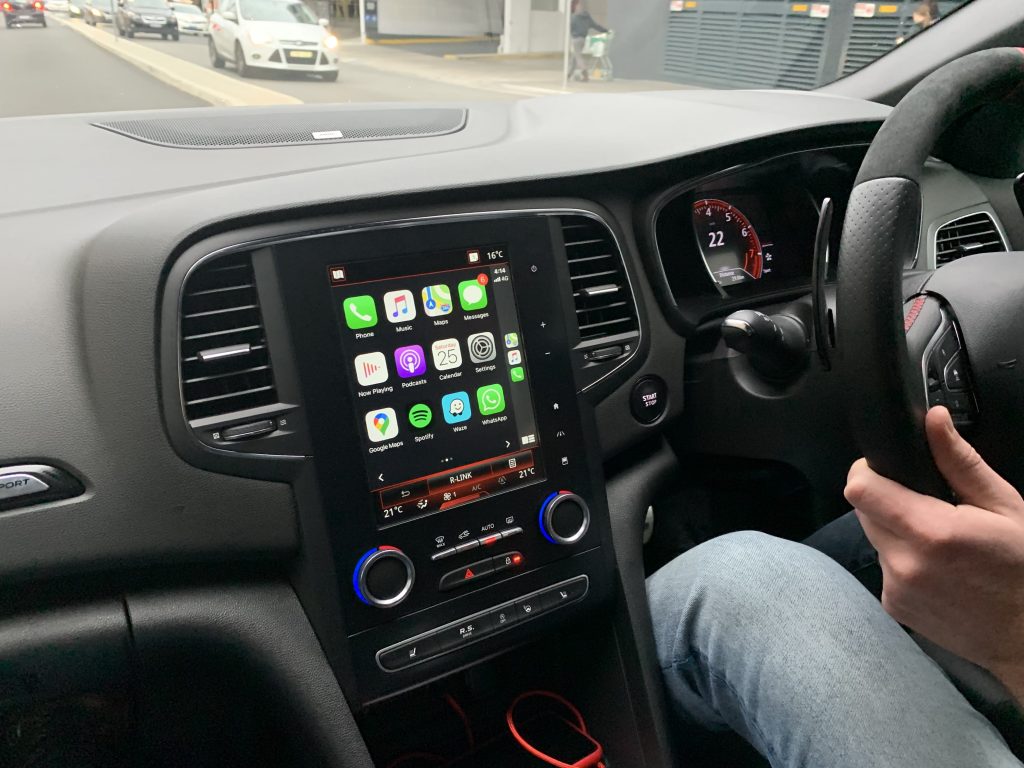
The 8.7-inch portrait infotainment touchscreen is good in theory but has a few quibbles. The menus are logical enough, but there are a lot of menus within menus that you can easily get lost in while on the move. This also isn’t helped by the fact that the screen itself sometimes doesn’t respond to inputs the way you expect to, meaning more time with eyes off the road. There are upsides though, including the fact that the temperature dials and the ‘auto’ and ‘demist’ buttons for climate control are physical. The RS Monitor app also allows you to show off in front of your friends by showing them the exact angle your wheels are turning, the amount of boost you’re generating or by timing your 0-100 sprint.
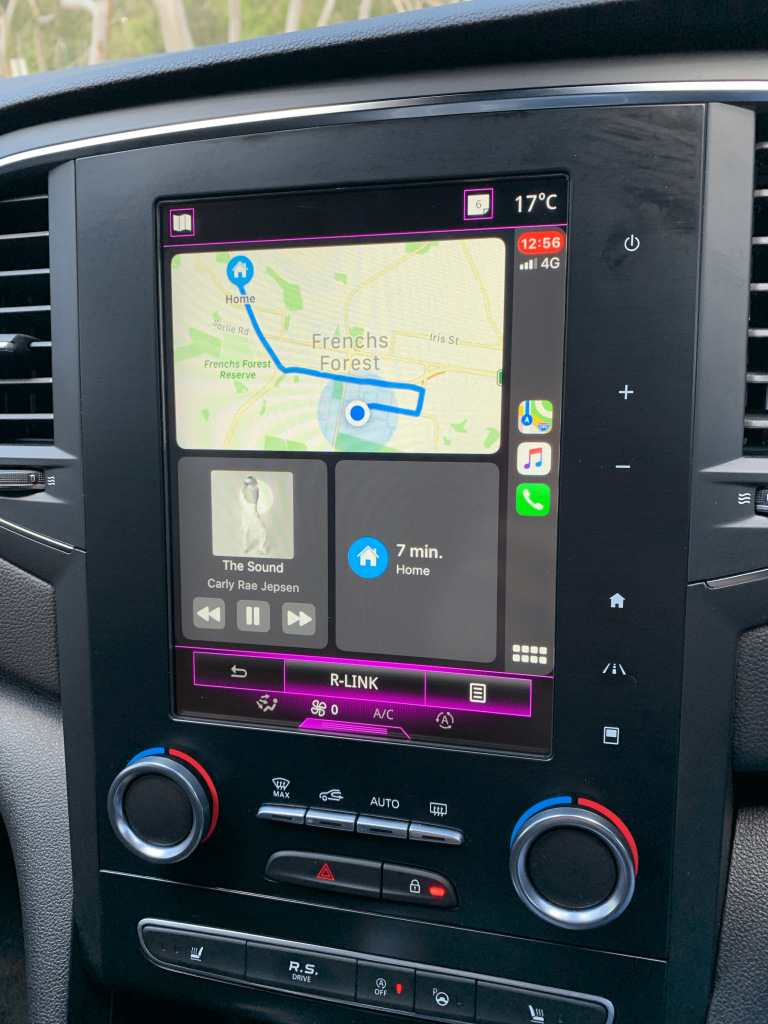
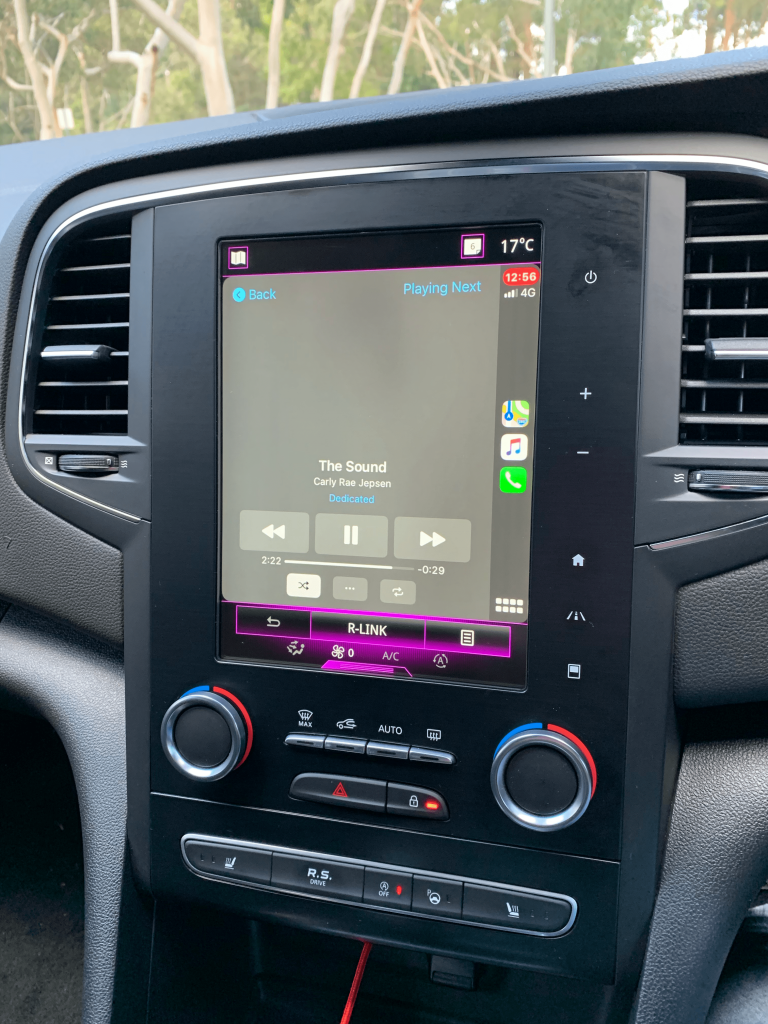
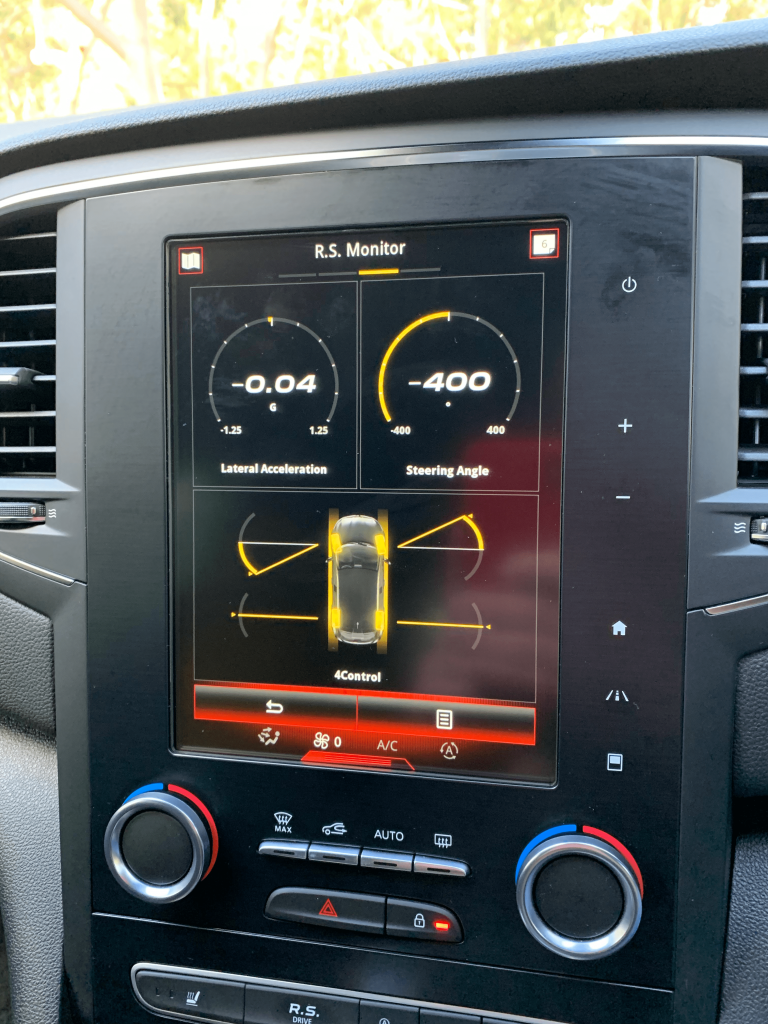
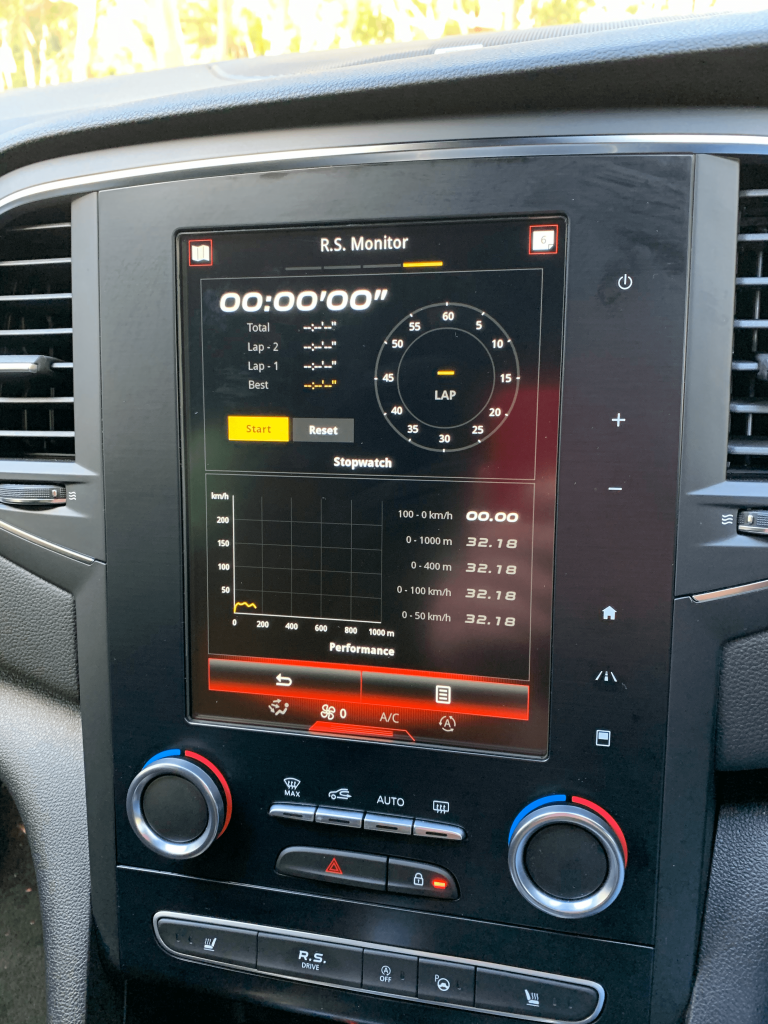
Apple CarPlay and Android Auto are both standard, with the former taking up the full screen rather than just a tiny letterbox. This is paired with a brilliant nine-speaker Bose sound system that remains distortion free no matter how loud you pump ‘Chromatica II’ transition into ‘911’.
The rear accommodation is par for the course, offering adequate knee room and good headroom. At 6’3 or 193cm tall, my knees are just touching the front seat set to my driving position. While the plastic on the door tops revert to hard in the second row, at least the rear passengers are treated to air vents, door bins, map pockets and a centre arrest with cupholders.
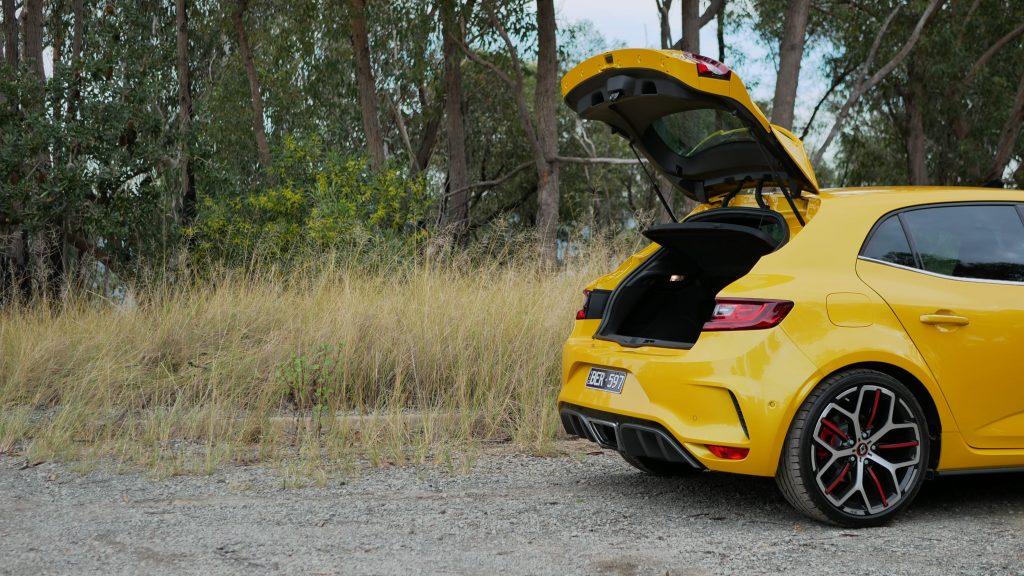
The 2020 Renault Megane also proves itself as a practical everyday car with a generous 434L boot, which is a notably bigger than the Golf R’s (343L) and even the sedan-like Civic Type R’s (414L). Those who plan to leave metropolitan areas will detest the lack of a spare wheel, having deal with a tyre inflation kit thanks to the large Bose subwoofer taking up the spare’s cavity.
Running Costs & Warranty: 8/10
French cars get a bad rap for being expensive to run, and while they’re by no means the worst, the Trophy EDC doesn’t make a great case for itself. While the facelifed Koleos and new Kadjar are covered by Renault Australia’s five-year ‘Easy Life’ servicing, which includes consumables like fluids and filters in the price of the service, the Megane sticks with Renault’s older three-year program. Additional items, such as the aforementioned fluids and filters, can add to the cost of each visit.
Trophy buyers who opt for the EDC are certainly going to pay for it, as the first service is a whopping $400 more than the manual – totalling at $799. That coupled with the cost of choosing EDC over the manual is enough to make you seriously consider swapping cogs yourself.
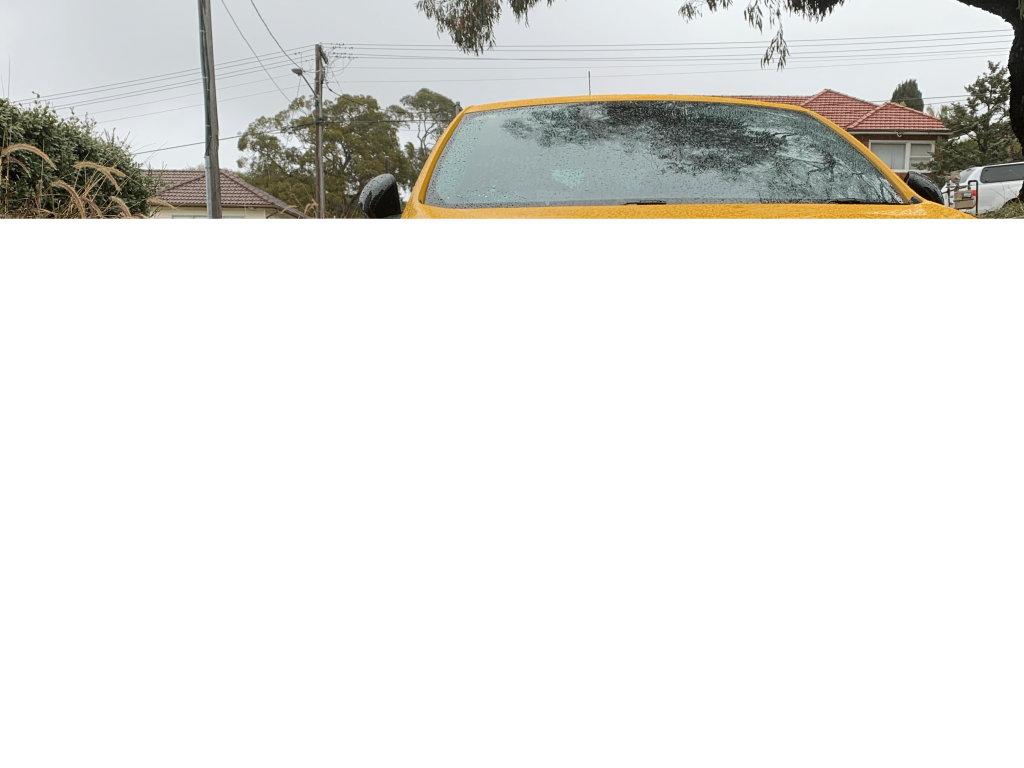
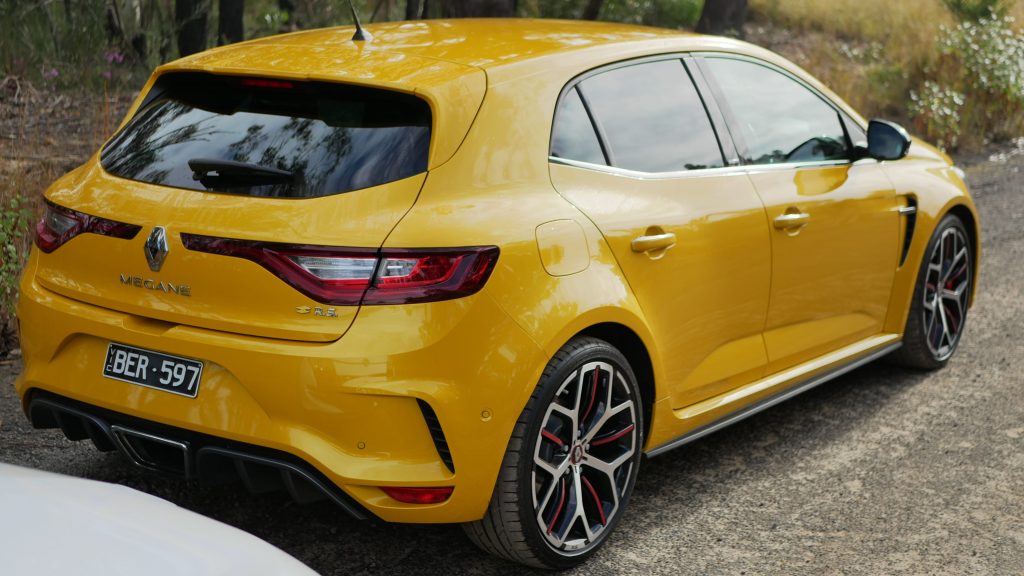
Over the first three years the total cost of servicing tallies up to $1,597 – which is cheaper than a Volkswagen Golf R, at $1,633 over three years, but notably more than a Honda Civic Type R, costing a sensible $969 in the same time. And if the Civic sounds like a bargain, Hyundai i30 N owners will be laughing as they can choose to buy a three-year service pack for a miserly $897.
If you cover a lot of kilometres the 2020 Renault Megane claws back some points as it only needs to visit the dealership every 20,000km, versus 15,000km for the Golf and 10,000km for the Civic and Hyundai. If you do rack up 60,000km in the first three years, the Megane is actually cheaper to service than both the Golf ($2,799) and Civic ($1,938).
“If you cover a lot of kilometres the Megane claws back some points as it only need to visit the dealership every 20,000km…”
The Trophy is also covered by Renault’s five-year/unlimited kilometre warranty for peace of mind.
2020 Renault Megane R.S. 300 Trophy EDC DiscoverAuto Rating: 8.8/10
Even with Renault Australia struggling to justify passenger cars in SUV-obsessed Australia, the Renault Sport Megane ultimately earns its spot in the local lineup. Like its much-lauded predecessor, the new RS300 Trophy is at the very top of the hot hatch pack in terms of performance, handling and driver engagement. Yet the new model adds a layer of finesse and versatility that earlier models just couldn’t offer.

Sure, it won’t ride as well as a some of its less hardcore competitors and it might not have the roomiest back seat in the class, but it’s grown up and now does very little wrong. The five-door body means you can easily get your friends in the back or fit a child seat without being a contortionist. The better equipped and higher quality interior better justifies the price tag. It now offers a dual-clutch transmission alongside the manual – opening the RS up to potential buyers who wouldn’t have even considered one in the past. Best of all, you’ll get a cracking driver’s car regardless of which you pick. There are many cars twice the price that won’t make you smile as much as a good hot hatch, and this is one of the very best of the breed.
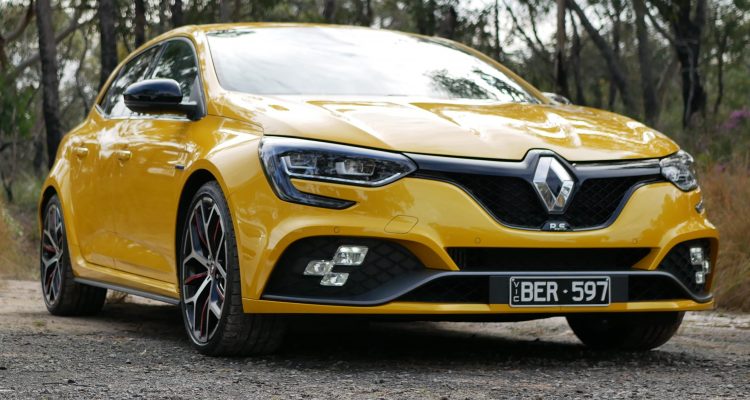
Leave a Reply